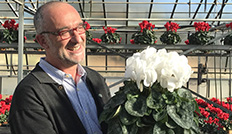 Professional area | Diseases factsheet | Pests | Leafminer
Professional area | Diseases factsheet | Pests | Leafminer
Liriomyza cyclaminis is so far hardly present at all in France. It is, however, an extremely damaging cyclamen pest.
The female pierces the tissue and the larvae dig tunnels, both of which can severely harm the plant.
By piercing the cell walls, Liriomyza cyclaminis can transmit viral and bacterial disease-causing organisms.
The same plant hygiene products can be used as for thrips.
Biological measures also give good results.
Leafminers are a major problem for glasshouse growing in Europe, affecting cyclamen as well as other plants.
The Leafminer belongs to the order Diptera (one pair of wings, large compound eyes), and the family Agromyzidae. The small fly larvae in this family are strictly vegetarian. Their particular characteristic is the making of tunnels or ‘mines’ in leaves, stalks, roots and tubers, or in the growing layer under bark. The most obvious members of this group of species are the Leafminers.
Agromyzidae are highly specialised. Nearly 99.4% of species may be regarded as feeding only on a single plant species, or on a very small number. On the other hand the fly species are in most cases very similar to each other in body layout, so that they are easily confused by anyone but a specialist. The most harmful species are those of the genus Liriomyza, of which L. cyclaminis is the one found on cyclamen. It feeds only on this one plant.
The development cycle of the Leafminer involves:
The adults measure 1.6 mm to 3.5 mm on average. They have a generally blackish or greyish colour, sometimes with some yellow. The wings are small and completely transparent. The average life span of an individual is 10 to 15 days. They are active by day: mating, feeding and laying.
To feed or to lay, the female fly makes a hole in the upper surface of a leaf with her spike: the hole can be seen with the naked eye. When she has laid her egg inside, the hole becomes oval. The males also feed from holes made by the females.
The eggs (from a few dozen to around a hundred, depending on the conditions) are small, from 0.2 to 0.35 mm long and from 0.08 to 0.12 mm across. She does not lay in overcast weather, and prefers to lay in the morning. The eggs take a few days to incubate.
The larvae are legless, whitish yellowish or greenish. They are in a ‘C’ shape, and some 3 to 5 mm. As soon as the larva appears it digs a tunnel, and as it develops, it digs a number of such tunnels, straight or bent, which account for its name. These cavities are generally white, with blackish patches of damp and chestnut-brown patches of dry: it is possible to see the larvae through the tunnel walls. Sometimes they move to other leaves via the stalk, but they never emerge onto the outside.
At the end of the larval stage they make a crescent-shaped exit in the epidermis of the leaf by means of their mouth hooks. They leave the leaf and drop to the ground, for metamorphosis takes place in the ground and not in the tunnels. The pupae look like tiny barrels, segmented and somewhat rounded, more or less brownish in colour, and 2 to 5 mm long. In natural conditions this species has two generations in a year; the first lives from February to December, with a long dormant period pupating from the beginning of spring until autumn; the second generation is from December to the next February.
It is the larvae and the adults that cause the damage.
Leafminer larvae cause direct and indirect damage. The tunnels they dig can easily be seen. As they consume the mesophyllum of the leaves, they decrease the availability of chlorophyll for photosynthesis, which slows down so that the leaves wither and fall off. Young plants are particularly susceptible.
The adult fly can also do a certain amount of harm, though neither as spectacular nor as pernicious as that of the larvae. The direct damage is done with the piercing for feeding or laying; these pricks develop into necrotic spots which spoil the plant and can reduce leaf area. One lone female can make hundreds of pricks.
Then there are other forms of damage, since the holes made can admit a number of pathogenic organisms.
The females can themselves also transmit viral or bacterial infections by injection, passing from a diseased plant to a healthy one.
Biological control by means of tiny parasitic beetles is really effective; it is the most advantageous method. The best-known parasites of Liriomyza sp in glasshouses are Dacnusa sibirica, Diglyphus isaea, Opius pallides. They are parasites of the larval stage.
These parasites are of the Braconidae family: they are very like each other. They are black or dark reddish-brown and 2 to 3mm long. They have long antennae and a pair of long wings.
They are internal parasites, laying their eggs inside the host (the first and second larval stages of the Leafminer). The adults later leave the host at the pupa stage. The parasites’ life-cycle is quicker than their hosts’.
These two parasites hunt by first of all seeking out a damaged plant: then they quickly set about finding their prey.
Commercial preparations of Dacnusa sibirica are:
This is an external parasite of the Eulophidae family. The adult is black, with small antennae and short wings. The adult female first finds a larva for a victim, then lays an egg beside it. When the egg hatches, the resultant larva will consume the prey. The sign that this parasite is at work is the presence of short tunnels in the leaves. At the end of its larval stage, the D.isaea larva uses tunnels dug by its victim to metamorphose in. The adult parasite leaves the tunnel by making a hole in the upper surface of the leaf. It has a quicker life-cycle than its host.
The relevant commercial preparations are
Combination products of Diglyphus and Dacnusa are sold under the names:
The parasites are delivered as adults in bottles.
Diglyphus isaea is recommended when there are large Leafminer colonies and it is warm. 200 adults are released per square metre.
Dacnusa sibirica is recommended while fly colonies are still small or when the temperature is low in winter or spring. 200 adults are released per sq.m.
Studies are also currently under way to evaluate the use of nematodes that cause disease in insects.
The proliferation of Leafminers is often linked with human activity. Every choice of combat measures must suit the pest concerned and the plants to be protected, as well as the growing environment.
The constant development of the regulations and homologations of phytosanitary treatment products, and the differences in regulations according to each country make it impossible for us to include updated information on homologations. Each producer will have to contact his local plant protection bureau to obtain the latest updates concerning the regulations and use of phytosanitary products. We strongly advise testing beforehand on a plant sample in order to measure the chemical’s activity (establishing the dose) and any effect on the plant (plant poisoning).
This advice sheet is based on the methods used at the SCEA at Montourey (Fréjus, France). These procedures may need some modification to adapt them to other climatic situations. Before starting to grow cyclamen there needs to be a review of precautions against pests and diseases. We must point out that our advice and suggestions are offered for information purposes and therefore cannot include any guarantee of specific results; it is a good idea to carry out trials beforehand.

2565, rue de Montourey
83600 Fréjus - France
International telephone : +33 (0)4 94 19 73 04
Switchboard : + 33 (0)4 94 19 73 00
Fax : +33 (0)4 94 19 73 19

